William Frederick Witherington (1785-1865) stands as a significant, if sometimes overlooked, figure in the landscape of 19th-century British art. An accomplished painter and a respected member of the Royal Academy, Witherington dedicated his career to capturing the idyllic charm and gentle human narratives of the English countryside. His work, characterized by its warmth, detailed observation, and pleasing compositions, offers a valuable window into the popular tastes and artistic currents of his time, distinct from the more dramatic or socially critical art of some of his contemporaries.
Early Life and Artistic Formation
Born in Goswell Street, London, on May 26, 1785, William Frederick Witherington's early life was set against the backdrop of a rapidly changing Britain. The late 18th and early 19th centuries were periods of industrial growth, social upheaval, and burgeoning national identity, all of which subtly influenced the arts. Witherington's initial inclinations were not solely artistic; he was also described as a scholar, suggesting a broad intellectual curiosity.
His formal artistic training commenced in 1805 when he enrolled as a student at the prestigious Royal Academy Schools. This institution was the crucible of British art, founded by luminaries such as Sir Joshua Reynolds and Thomas Gainsborough, and it provided a rigorous education grounded in classical principles and the study of Old Masters. Here, Witherington would have honed his skills in drawing, perspective, and composition, alongside aspiring artists who would become his peers and, in some cases, friendly rivals. He was a diligent student, and his commitment to his craft was evident from early on.
The Royal Academy and Early Career
The Royal Academy of Arts was not just an educational institution; it was the epicenter of the British art world, and its annual exhibitions were major social and cultural events. For an aspiring artist, exhibiting at the Royal Academy was a crucial step towards recognition and patronage. Witherington made his debut at the Summer Exhibition in 1811, and from that year until his retirement from active exhibition in 1863, he was a remarkably consistent contributor. This long and steady presence speaks to his dedication and the consistent appeal of his work to the selection committees and the public.
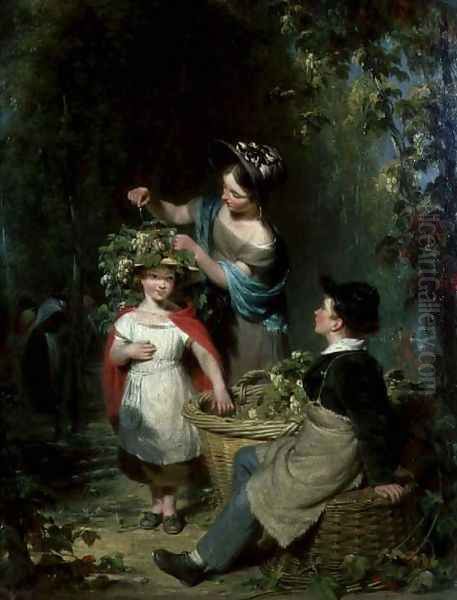
His early works, as noted by art historians, were predominantly landscapes. This was a genre that had gained immense popularity in Britain, building on the foundations laid by artists like Richard Wilson, who brought a classical sensibility to British scenery, and the more naturalistic approaches of Thomas Girtin and the early J.M.W. Turner. Witherington's initial landscapes likely focused on the picturesque qualities of the English countryside, a theme that would remain central to his oeuvre.
Evolution of Style: The Introduction of Figures
A significant development in Witherington's artistic journey was the increasing incorporation of figures and narrative elements into his landscapes. This shift is often attributed to the influence of artists like George Morland (1763-1804). Morland was renowned for his rustic scenes, often depicting rural laborers, charming cottage exteriors, and animals with a sentimental but observant eye. His work resonated with a public that was increasingly nostalgic for a perceived simpler, agrarian past, even as industrialization transformed the nation.
Witherington, however, carved his own niche within this tradition. While Morland sometimes depicted the more rugged or even dissolute aspects of country life, Witherington's vision was generally more polished and idealized. He excelled in portraying the gentle, heartwarming aspects of rural existence, focusing on family life, children at play, and communal activities. His figures are not mere accessories to the landscape; they are integral to the scene, imbuing it with life, emotion, and narrative interest. This approach aligned him with the broader trend of genre painting, which was gaining prominence through artists like Sir David Wilkie, whose depictions of Scottish peasant life were immensely popular.
Themes and Subject Matter: An Idyllic Vision
Witherington's canvases are populated with scenes that evoke a sense of tranquility and domestic harmony. He consciously avoided the depiction of rural hardship, poverty, or the grueling labor that was a reality for many in the countryside. Instead, his focus was on moments of leisure, simple pleasures, and the picturesque. This choice reflects both his personal artistic temperament and the preferences of his patrons, who often sought art that was pleasing, uplifting, and affirmed a romanticized view of rural England.
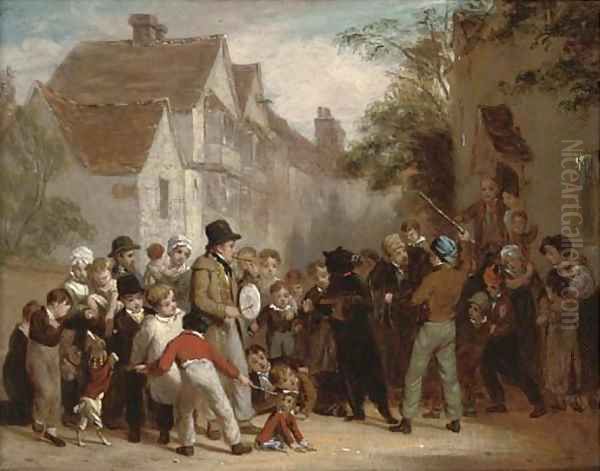
His subjects frequently included children engaged in innocent pastimes, families enjoying the outdoors, and scenes of village life. He had a keen eye for the details of costume, gesture, and interaction, which lent authenticity to his idealized portrayals. Unlike the sublime and often turbulent landscapes of J.M.W. Turner or the deeply personal and atmospheric studies of John Constable, Witherington's work offered a more accessible and comforting vision of nature, one that was humanized and domesticated. His contemporary, William Mulready, often explored similar themes of rural and domestic life, sometimes with a more overtly sentimental or moralizing tone.
Compositional Characteristics
A hallmark of Witherington's style was his skillful composition. He typically placed his figures prominently in the foreground, allowing the viewer to engage directly with the narrative. The middle ground often featured elements of the rural setting – cottages, fields, or pathways – while the background frequently opened up to reveal distant woods, rolling hills, or a luminous sky. This layering created a sense of depth and expansiveness, even in relatively intimate scenes.
His compositions are generally well-balanced and harmonious, with a clear articulation of space. He paid careful attention to the play of light and shadow, using it to model his figures and to create a sense of atmosphere. His palette was typically bright and cheerful, reflecting the optimistic tone of his subjects. While he never travelled abroad, his deep familiarity with the English landscape provided him with an inexhaustible source of inspiration. His ability to capture the specific character of English scenery – its lush greenery, changeable skies, and ancient trees – was a key strength.
Notable Works: A Closer Look
Several paintings stand out as representative of Witherington's artistic achievements and thematic concerns.
The Hop Garland
Exhibited in 1834, The Hop Garland (also known as The Hop Garden) is one of Witherington's most celebrated works. It depicts a charming scene of young women and children in a hop garden, engaged in the traditional activity of picking hops and weaving them into garlands. The painting is a symphony of gentle activity and rustic beauty. The figures are gracefully rendered, their expressions animated and their interactions natural. The lush greenery of the hop bines forms a verdant backdrop, and the overall atmosphere is one of joyful, communal labor transformed into a picturesque idyll. The painting showcases Witherington's skill in figure painting, his ability to manage complex group compositions, and his talent for capturing the textures and colors of the natural world. It is a quintessential example of his idealized vision of rural life, reminiscent in its charm of some of the works of Thomas Webster, another contemporary known for his delightful scenes of childhood and village life.
The Dancing Bear
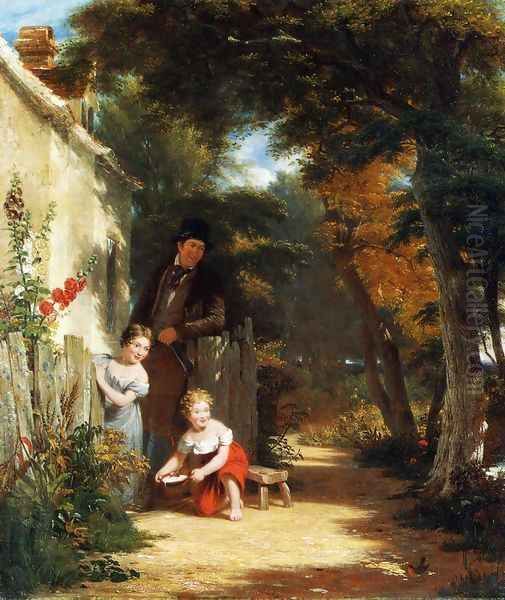
This work, while sharing the rural setting common to Witherington's art, introduces a slightly different, perhaps more "singular and dreamlike" element, as one source described it, even hinting at an "eerie violence." The subject of a travelling entertainer with a dancing bear was a familiar sight in 19th-century Europe, and it offered artists an opportunity to explore themes of spectacle, the exotic, and the interaction between humans and animals. While Witherington's treatment would likely still lean towards the picturesque, the inherent nature of the subject – a wild animal trained for entertainment – could indeed introduce a subtle undercurrent of unease or pathos, distinguishing it from his more purely idyllic scenes. This work might be compared to the animal paintings of Sir Edwin Landseer, though Landseer often imbued his animal subjects with more overt anthropomorphic qualities and dramatic narratives.
The Robin
The Robin (1839) is another example of Witherington's ability to capture intimate family moments within a landscape setting. The painting reportedly depicts a father and his two children on a country path, observing a robin. Such a scene is imbued with a quiet tenderness and a sense of shared experience. The robin, a familiar and beloved bird in British culture, adds a touch of natural charm and perhaps a subtle symbolism of domesticity or the changing seasons. The composition would likely emphasize the close bond between the family members and their harmonious relationship with the natural world around them. This focus on simple, everyday interactions is a recurring motif in Witherington's art.
A Modern Picture Gallery (1824)
This painting, created in collaboration with Paul Legrand, is a fascinating and somewhat unusual work in Witherington's oeuvre. It depicts the interior of a fictional art gallery, showcasing a collection of contemporary British paintings from the 18th and early 19th centuries. While the individual artworks within the gallery are imagined, the painting as a whole serves as a commentary on the burgeoning British school of art and the growing public interest in collecting and displaying modern works. It reflects a sense of national pride in British artistic achievements and provides a valuable insight into the exhibition practices and tastes of the period. Such "gallery pictures" were a recognized sub-genre, allowing artists to display their virtuosity and to engage with the art world itself. It speaks to Witherington's engagement with his contemporary art scene, which included figures like the portraitist Sir Thomas Lawrence and the history painter Benjamin Robert Haydon, all contributing to the vibrant artistic milieu of London.
Recognition and Academic Standing
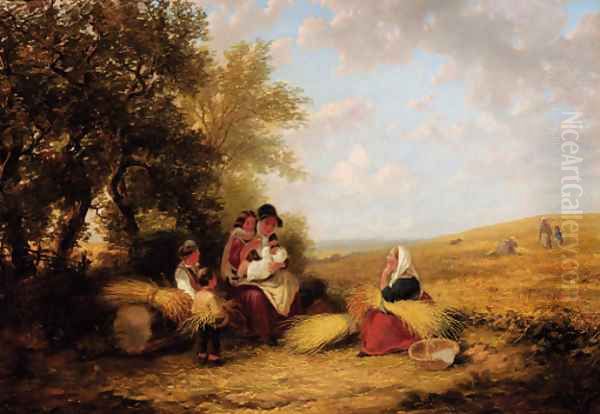
Witherington's consistent contributions to the Royal Academy exhibitions and the appealing nature of his work did not go unnoticed by his peers. In 1830, he was elected an Associate of the Royal Academy (A.R.A.), a significant step in an artist's career, signifying recognition by the established members of the institution. A decade later, in 1840, he achieved the distinction of being elected a full Royal Academician (R.A.), the highest honor for an artist in Britain at the time. This placed him among the elite of the British art world, alongside painters like Charles Lock Eastlake, who would later become President of the Royal Academy, and Clarkson Stanfield, a renowned marine and landscape painter.
His status as an R.A. would have brought him increased prestige, opportunities for patronage, and a role in the governance and teaching activities of the Academy. His long and successful career within the Academy system underscores his adherence to its values and his ability to consistently produce work that met its standards of excellence.
Later Life and Legacy
William Frederick Witherington continued to paint and exhibit regularly until his retirement from active participation in the Royal Academy exhibitions in 1863. He passed away on April 10, 1865, at the age of 79, in his home in Mornington Crescent, London. He left behind a substantial body of work that provides a charming and detailed record of a particular vision of English rural life.
His paintings found their way into numerous private and public collections. Today, his works are held in esteemed institutions such as the Victoria and Albert Museum in London, the National Gallery, and the Royal Academy itself, as well as various regional galleries throughout the United Kingdom. The presence of his art in these collections ensures its accessibility to future generations and its continued study by art historians.
While Witherington may not have been a radical innovator in the vein of Turner or Constable, his contribution to British art is nonetheless significant. He was a master of his chosen genre, creating works that were technically accomplished, aesthetically pleasing, and emotionally resonant for his contemporary audience. His paintings catered to a widespread desire for images that celebrated the beauty of the English countryside and the virtues of simple, domestic life. This appeal was shared by other artists of the period, such as Thomas Creswick, who also specialized in idyllic English landscapes, or Frederick Goodall, known for his picturesque genre scenes, some set in rural England before he turned to Orientalist subjects.
Art Historical Context and Evaluation
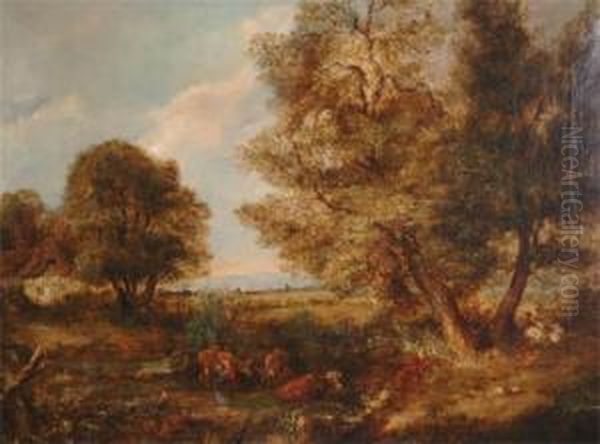
In the broader context of 19th-century British art, Witherington occupies a position as a skilled and popular practitioner of landscape and genre painting. His work can be seen as part of a tradition that idealized rural life, offering an antidote to the perceived ills of industrialization and urbanization. This romanticized vision was not unique to Witherington; it was a powerful cultural current that found expression in literature and art throughout the Victorian era.
Compared to the Pre-Raphaelite Brotherhood, who emerged in the mid-19th century with their emphasis on truth to nature, intense detail, and often literary or medieval subjects (think of John Everett Millais or Dante Gabriel Rossetti), Witherington's style was more traditional, rooted in the picturesque conventions of the early 19th century. He did not engage with the social realism that began to emerge in the work of artists like Luke Fildes or Hubert von Herkomer later in the century, who depicted scenes of poverty and urban life.
Witherington's strength lay in his ability to create consistently charming and well-crafted paintings that appealed to the sensibilities of his time. His focus on the positive and harmonious aspects of life, his technical proficiency, and his dedication to his craft earned him a respected place within the Royal Academy and the affection of the public.
The anecdote about a sketch initially attributed to the early Netherlandish master Lucas van Leyden being later reattributed to Witherington is an interesting footnote. Such instances of misattribution or reattribution are common in art history and highlight the complexities of connoisseurship and scholarly research. It also suggests that Witherington's draughtsmanship, at least in certain instances, could achieve a quality that might be mistaken for that of an earlier master, even if their overall styles were vastly different.
The mention of his brother, Frederick Witherington, as "the hermit of Norfolk Street" due to his eccentric behavior, is a colorful biographical detail that adds a touch of human interest to the family story, though it doesn't directly bear on William Frederick Witherington's artistic practice or reputation. Similarly, the ancestral Widdringtons' involvement in the English Civil War is part of a deeper family history but far removed from the painter's own life and times.
Conclusion: An Enduring Charm
William Frederick Witherington R.A. was an artist who found his voice in the gentle depiction of English rural life. His paintings, filled with sunny landscapes, happy children, and harmonious family groups, offered his contemporaries a comforting and idealized vision of their nation's countryside. He was a skilled craftsman, a consistent exhibitor, and a respected member of the Royal Academy. While his art may not possess the revolutionary power of some of his more famous contemporaries, its enduring charm, technical competence, and historical value secure his place as a noteworthy figure in the rich tapestry of 19th-century British painting. His work continues to be appreciated for its gentle beauty and its affectionate portrayal of a bygone era, providing a picturesque counterpoint to the more dramatic or socially engaged art of his time, and standing alongside the works of other popular landscape and genre painters like John Linnell or Francis Danby, who each offered their own distinct visions of nature and human life.